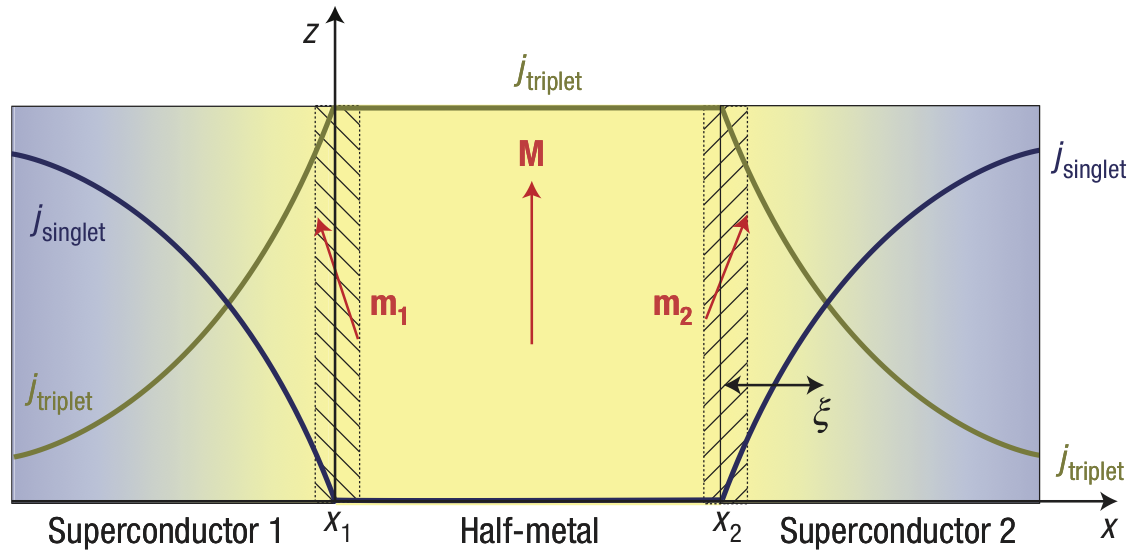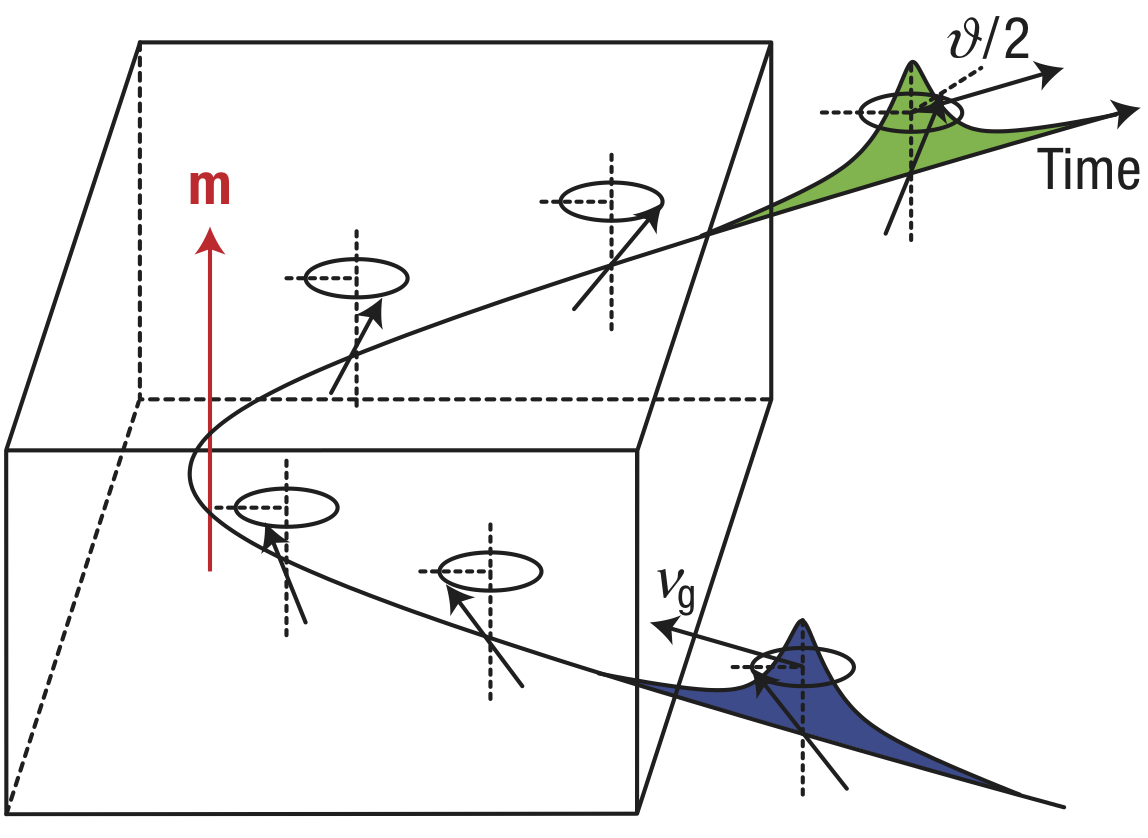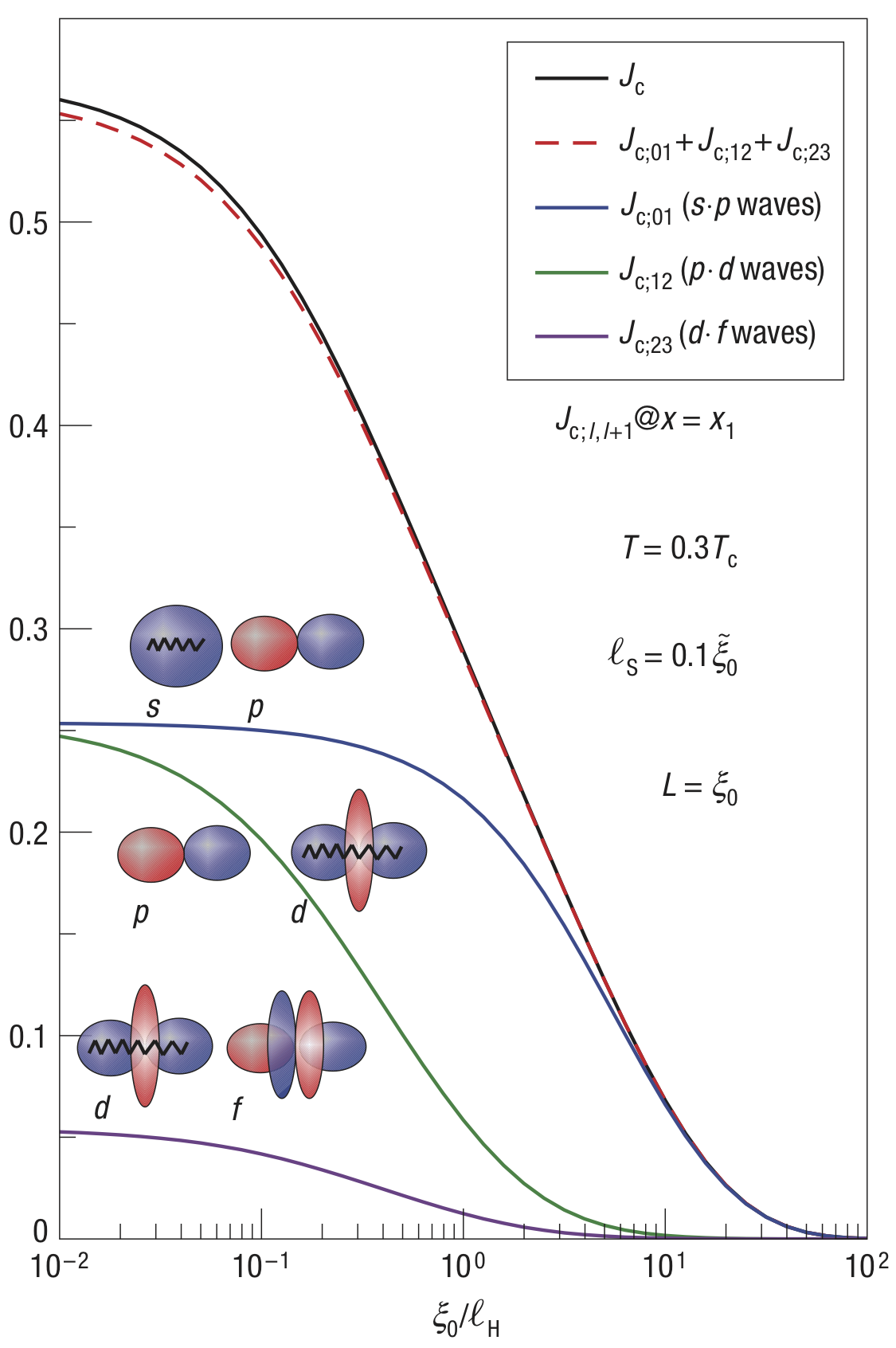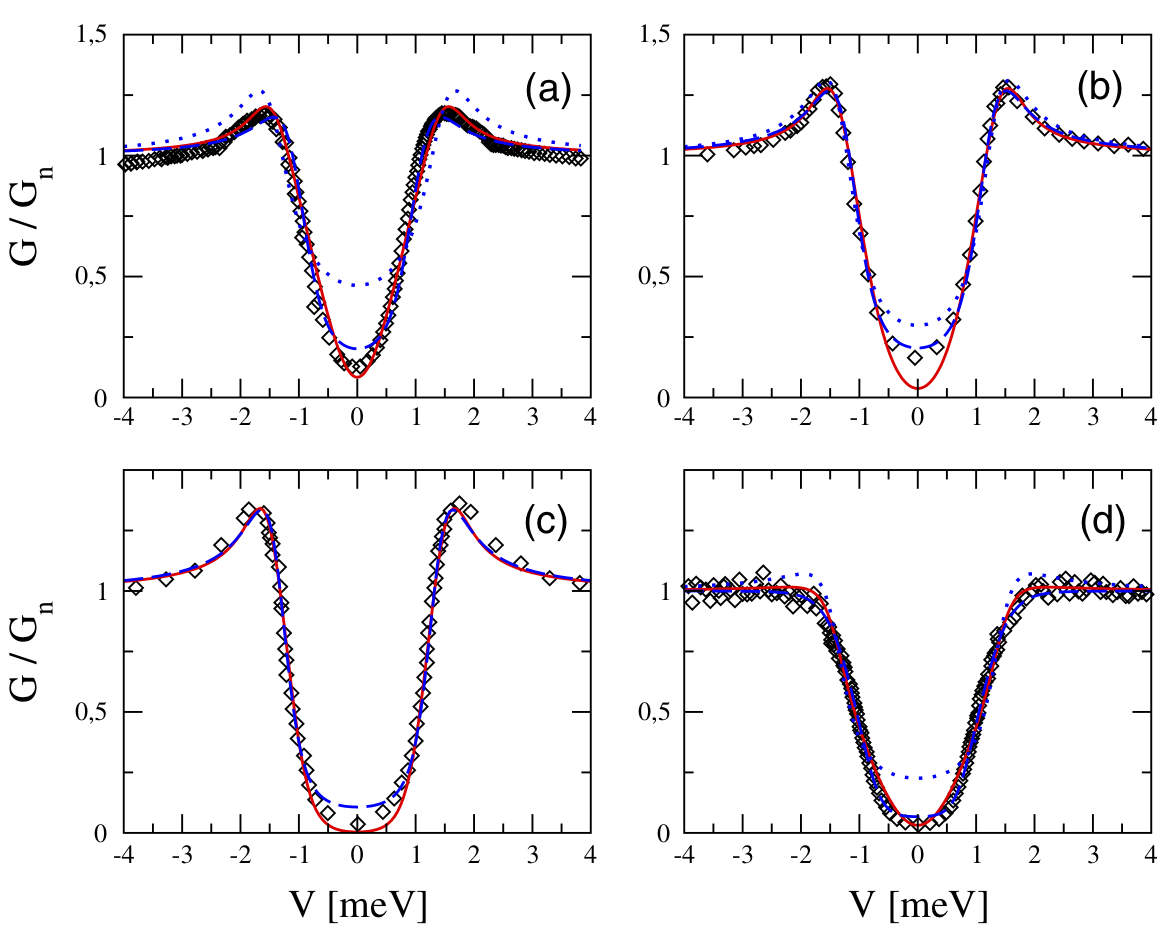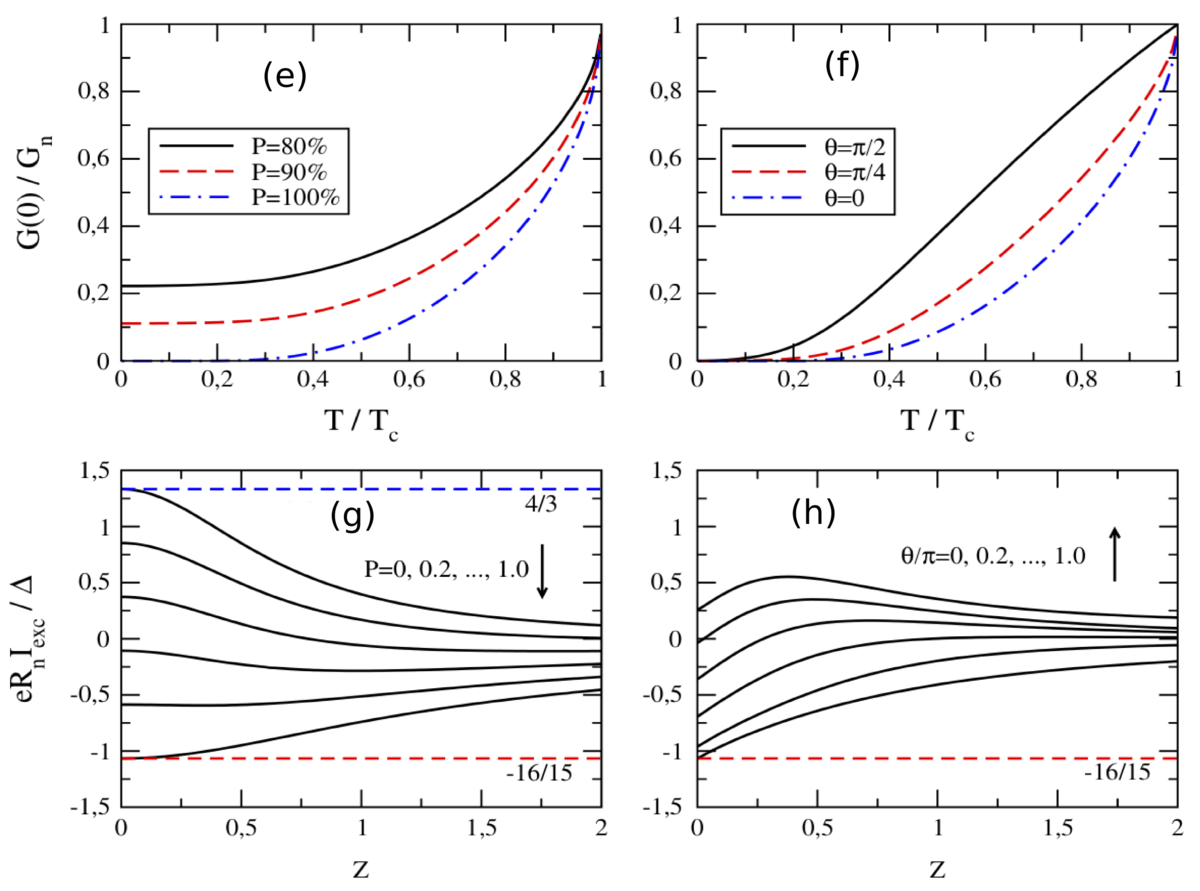B2.6: Quasiclassical Theory of Superconducting and Ferromagnetic Hybrid Devices
Subproject Leader: Gerd Schön
Contributing Scientists:
Present: Roland Grein, Dmitri Golubev, Jens Michelsen
Past: Matthias Eschrig (since 11.2010 at Royal Holloway Univ. London),
1. Proximity Effect Between Superconductors and Strongly Spin-Polarized Ferromagnets
Interfaces between materials with different ordered phases present unique opportunities to study the competition between the underlying mechanisms. An interesting example is an interface between a singlet superconductor, where Cooper pairing occurs between electrons with opposite spin, and a half-metallic ferromagnet with 100% spin polarization. Since these two orders cannot coincide one would expect a very short penetration depth of the proximity effect and strong suppression of the Josephson coupling. In an earlier funding period we predicted an enhanced proximity effect, with decay length of the order of the conventional superconducting correlation length and accompanying Josephson coupling, due to induced triplet spin pairing mediated by spin-flip centers in the interface region. Our predictions were confirmed in experiments observing a supercurrent through half-metallic CrO2 and in a number of further setups. The experiment performed by the Klapwijk group was further explained and analyzed by us [1,2]. In Ref. [3] we extended our theory from half-metallic ferromagnets to those with strong, but not complete spin-polarization, appropriate for most ferromagnetic elements, like Fe, Ni, Co. The presence of a minority band in the FM leads to important new physical effects. We found that the temperature anomaly predicted for the half metallic case is suppressed with decreasing spin-polarization and predicted a pure spin-supercurrent in a SC/FM bilayer terminated by a spin-active surface.
2. Point-Contact Andreev Spectroscopy and the Role of Spin-Active Scattering
Spin-active scattering in the interface region between superconducting and ferromagnetic materials are crucial for the creation of triplet pairing correlations and supercurrent. Spin-rotation and spin-flip scattering, the decisive ingredients of the long-range triplet proximity effect, are usually described through a phenomenological scattering matrix which enters the boundary conditions for the quasiclassical Green’s functions. We derived the normal-state scattering matrix from a microscopic model and found that for sharply localized potentials the spin rotation effect is weak, while the more realistic case of smooth scattering potential leads to a sizable magnitude of the spin rotation angle.
The spin-mixing effect leads to spin-polarized bound states at the interface which, given a sufficiently strong spin-rotation effect, will show up as subgap peaks in the conductance spectrum. Evidence for such states has recently been found by experimentalists of the CFN (D. Beckmann et al., B2.7). Our theory was successfully fitted to various conductance spectra of CrO2 available in the literature [4]. These data had all been fitted with the Blonder-Tinkham-Klapwijk (BTK) theory which indicated a large spread in the extracted spin-polarization of the material, whereas other experimental techniques suggest the material to be close to half metallic. The assumption of spin-flip centers in the interface region allows us to fit the data to fully polarized half metals. We also identified several characteristic features that allow for a clear distinction between the two models in a new generation of experiments.
3. Crossed Andreev Reflections
The term non-local conductance refers to transport processes in multi-terminal devices which correlate charge transfer at different contacts. In practice, this can be quantified by the conductance dI1/dV2, relating the current at contact 1 to the voltage at contact 2. The non-local conductance of a NSN structure is dominated by two competing processes: Elastic co-tunneling (EC), and Crossed Andreev Reflection (CAR). CAR may be seen as a source of spatially separated, entangled quasiparticles where a Cooper pair from the superconductor is split up into two entangled electrons tunneling into different normal leads. The ability to produce such an entangled pair of well separated particles in a solid state device is an intriguing feature for quantum information purposes. Much effort – both experimentally and theoretically – is devoted to identifying scenarios where the CAR contribution to the nonlocal conductance is enhanced. One proposal is to use FSF and NSN structures with spin-active interfaces, for which we developed a microscopic theory of non-local electron transport within the framework of the quasiclassical Green’s function formalism. This theory demonstrates that CAR in such devices is highly sensitive to electron spins and that the presence of spin-active scattering at the magnetic interfaces leads to a complicated subgap structure of the non-local conductance. This structure can be fully understood by CAR and EC processes mediated by the interface bound states, which are induced by the spin-rotation effect at both interfaces.
Complementary to the work on ballistic heterostructures, we also investigated disorder and non-equilibrium effects in NSN structures, in particular the interplay between CAR, EC and charge imbalance induced by quasiparticle injection. We could demonstrate that the combination of two competing processes – Andreev reflection and charge imbalance – yields a pronounced peak in the temperature dependence of non-local resistance, which fits to recent experimental observations by Beckmann et al. (CFN subproject B2.7). In Ref. [5] we incorporated several additional effects such as the proximity effect in the normal leads, the inverse proximity effect in the superconductor, and arbitrary transparency of the junctions. The combination of all these phenomena results in negative dI1/dV2, i.e. EC turns out to be stronger than CAR. Positive dI1/dV2 is commonly observed in experiments. We could show that positive dI1/dV2 may be a result of Coulomb interaction in a certain range of parameters.
Literature
| [1] | M. Eschrig, T. Löfwander, T. Champel, J.C. Cuevas, J. Kopu, and G. Schön, Symmetries of pairing correlations in superconductor-ferromagnet nano-structures, J. Low Temp. Phys. 147, 457 (2007) |
| [2] | M. Eschrig and T. Löfwander, Triplet supercurrents in clean and disordered half-metallic ferromagnets, Nature Physics, 4, 138 (2008) |
| [3] | R. Grein, M. Eschrig, G. Metalidis, and G. Schön, Spin-Dependent Cooper Pair Phase and Pure Spin Supercurrents in Strongly Polarized Ferromagnets, Phys. Rev. Lett. 102, 227005 (2009) |
| [4] | T. Löfwander, R. Grein, and M. Eschrig, Is CrO2 Fully Spin-Polarized? – Analysis of Andreev Spectra and Excess Current, Phys. Rev. Lett. 105, 207001 (2010) |
| [5] | D.S. Golubev, M.S. Kalenkov, and A.D. Zaikin, Crossed Andreev reflection and charge imbalance in diffusive Normal-Superconducting-Normal structures, Phys. Rev. Lett. 103, 067006 (2009) |
List of Publications 2006-2011 as PDF
Subproject Report 2006-2010 as PDF
